16: Europe and North America during the Modernist Revolution of 1904-1914
- Page ID
- 219619
\( \newcommand{\vecs}[1]{\overset { \scriptstyle \rightharpoonup} {\mathbf{#1}} } \)
\( \newcommand{\vecd}[1]{\overset{-\!-\!\rightharpoonup}{\vphantom{a}\smash {#1}}} \)
\( \newcommand{\id}{\mathrm{id}}\) \( \newcommand{\Span}{\mathrm{span}}\)
( \newcommand{\kernel}{\mathrm{null}\,}\) \( \newcommand{\range}{\mathrm{range}\,}\)
\( \newcommand{\RealPart}{\mathrm{Re}}\) \( \newcommand{\ImaginaryPart}{\mathrm{Im}}\)
\( \newcommand{\Argument}{\mathrm{Arg}}\) \( \newcommand{\norm}[1]{\| #1 \|}\)
\( \newcommand{\inner}[2]{\langle #1, #2 \rangle}\)
\( \newcommand{\Span}{\mathrm{span}}\)
\( \newcommand{\id}{\mathrm{id}}\)
\( \newcommand{\Span}{\mathrm{span}}\)
\( \newcommand{\kernel}{\mathrm{null}\,}\)
\( \newcommand{\range}{\mathrm{range}\,}\)
\( \newcommand{\RealPart}{\mathrm{Re}}\)
\( \newcommand{\ImaginaryPart}{\mathrm{Im}}\)
\( \newcommand{\Argument}{\mathrm{Arg}}\)
\( \newcommand{\norm}[1]{\| #1 \|}\)
\( \newcommand{\inner}[2]{\langle #1, #2 \rangle}\)
\( \newcommand{\Span}{\mathrm{span}}\) \( \newcommand{\AA}{\unicode[.8,0]{x212B}}\)
\( \newcommand{\vectorA}[1]{\vec{#1}} % arrow\)
\( \newcommand{\vectorAt}[1]{\vec{\text{#1}}} % arrow\)
\( \newcommand{\vectorB}[1]{\overset { \scriptstyle \rightharpoonup} {\mathbf{#1}} } \)
\( \newcommand{\vectorC}[1]{\textbf{#1}} \)
\( \newcommand{\vectorD}[1]{\overrightarrow{#1}} \)
\( \newcommand{\vectorDt}[1]{\overrightarrow{\text{#1}}} \)
\( \newcommand{\vectE}[1]{\overset{-\!-\!\rightharpoonup}{\vphantom{a}\smash{\mathbf {#1}}}} \)
\( \newcommand{\vecs}[1]{\overset { \scriptstyle \rightharpoonup} {\mathbf{#1}} } \)
\( \newcommand{\vecd}[1]{\overset{-\!-\!\rightharpoonup}{\vphantom{a}\smash {#1}}} \)
\(\newcommand{\avec}{\mathbf a}\) \(\newcommand{\bvec}{\mathbf b}\) \(\newcommand{\cvec}{\mathbf c}\) \(\newcommand{\dvec}{\mathbf d}\) \(\newcommand{\dtil}{\widetilde{\mathbf d}}\) \(\newcommand{\evec}{\mathbf e}\) \(\newcommand{\fvec}{\mathbf f}\) \(\newcommand{\nvec}{\mathbf n}\) \(\newcommand{\pvec}{\mathbf p}\) \(\newcommand{\qvec}{\mathbf q}\) \(\newcommand{\svec}{\mathbf s}\) \(\newcommand{\tvec}{\mathbf t}\) \(\newcommand{\uvec}{\mathbf u}\) \(\newcommand{\vvec}{\mathbf v}\) \(\newcommand{\wvec}{\mathbf w}\) \(\newcommand{\xvec}{\mathbf x}\) \(\newcommand{\yvec}{\mathbf y}\) \(\newcommand{\zvec}{\mathbf z}\) \(\newcommand{\rvec}{\mathbf r}\) \(\newcommand{\mvec}{\mathbf m}\) \(\newcommand{\zerovec}{\mathbf 0}\) \(\newcommand{\onevec}{\mathbf 1}\) \(\newcommand{\real}{\mathbb R}\) \(\newcommand{\twovec}[2]{\left[\begin{array}{r}#1 \\ #2 \end{array}\right]}\) \(\newcommand{\ctwovec}[2]{\left[\begin{array}{c}#1 \\ #2 \end{array}\right]}\) \(\newcommand{\threevec}[3]{\left[\begin{array}{r}#1 \\ #2 \\ #3 \end{array}\right]}\) \(\newcommand{\cthreevec}[3]{\left[\begin{array}{c}#1 \\ #2 \\ #3 \end{array}\right]}\) \(\newcommand{\fourvec}[4]{\left[\begin{array}{r}#1 \\ #2 \\ #3 \\ #4 \end{array}\right]}\) \(\newcommand{\cfourvec}[4]{\left[\begin{array}{c}#1 \\ #2 \\ #3 \\ #4 \end{array}\right]}\) \(\newcommand{\fivevec}[5]{\left[\begin{array}{r}#1 \\ #2 \\ #3 \\ #4 \\ #5 \\ \end{array}\right]}\) \(\newcommand{\cfivevec}[5]{\left[\begin{array}{c}#1 \\ #2 \\ #3 \\ #4 \\ #5 \\ \end{array}\right]}\) \(\newcommand{\mattwo}[4]{\left[\begin{array}{rr}#1 \amp #2 \\ #3 \amp #4 \\ \end{array}\right]}\) \(\newcommand{\laspan}[1]{\text{Span}\{#1\}}\) \(\newcommand{\bcal}{\cal B}\) \(\newcommand{\ccal}{\cal C}\) \(\newcommand{\scal}{\cal S}\) \(\newcommand{\wcal}{\cal W}\) \(\newcommand{\ecal}{\cal E}\) \(\newcommand{\coords}[2]{\left\{#1\right\}_{#2}}\) \(\newcommand{\gray}[1]{\color{gray}{#1}}\) \(\newcommand{\lgray}[1]{\color{lightgray}{#1}}\) \(\newcommand{\rank}{\operatorname{rank}}\) \(\newcommand{\row}{\text{Row}}\) \(\newcommand{\col}{\text{Col}}\) \(\renewcommand{\row}{\text{Row}}\) \(\newcommand{\nul}{\text{Nul}}\) \(\newcommand{\var}{\text{Var}}\) \(\newcommand{\corr}{\text{corr}}\) \(\newcommand{\len}[1]{\left|#1\right|}\) \(\newcommand{\bbar}{\overline{\bvec}}\) \(\newcommand{\bhat}{\widehat{\bvec}}\) \(\newcommand{\bperp}{\bvec^\perp}\) \(\newcommand{\xhat}{\widehat{\xvec}}\) \(\newcommand{\vhat}{\widehat{\vvec}}\) \(\newcommand{\uhat}{\widehat{\uvec}}\) \(\newcommand{\what}{\widehat{\wvec}}\) \(\newcommand{\Sighat}{\widehat{\Sigma}}\) \(\newcommand{\lt}{<}\) \(\newcommand{\gt}{>}\) \(\newcommand{\amp}{&}\) \(\definecolor{fillinmathshade}{gray}{0.9}\)Introduction
Paris had established itself as the center of the Western Art world for quite some time by the beginning of the 20th century, and two artists were gaining much attention. Henri Matisse and the Spaniard, Pablo Picasso, were competing with one another for attention and influence. Western patrons like Gertrude and Leo Stein financially supported artists like Picasso and helped young artists establish a following. However, with the radical painting Les Demoiselles da Avignon, Picasso alienated many of his admirers. The painting is so shocking it abandons all previous art conventions and establishes a new order and direction for art. It destroys the past and moves ahead in uncharted waters.
Influential concepts put forth in the Modernist Revolution will arise from the influential Bauhaus school in Germany. A house for building, as the German name suggests, will push concepts such as Form follows Function and Less is More, both vital ideas in the Modernist Movement. Abstraction ties into the concept of Less is More in that it can be a process of elimination and simplification. Less certainly can be more in visual art, however less can also leave the viewer wanting more in what appears to be an overly simplifies or unfinished work. This will become the grey area and struggle for many artists and designers in the years to come.

Mountains at Collioure, 1905 André Derain
André Derain continued to explore flattening of the space represented on the canvas in paintings like the Mountains at Collioure. The bold brushstrokes and the application of adjacent complementary colors used by Van Gogh is pushed even further in these new works. We also see the popular Art Nouveau style coming through in the organic lines. The color saturation is pushed to the limits and was disconcerting to the salon critiques who compared the group of artists, including Matisse, as acting like fauve (the French word for wild beasts). The term has remained attached to the work and artists from this time and they are referred to as the Fauvists with the art style termed Fauvism.
16: Europe and North America during the Modernist Revolution of 1904-1914
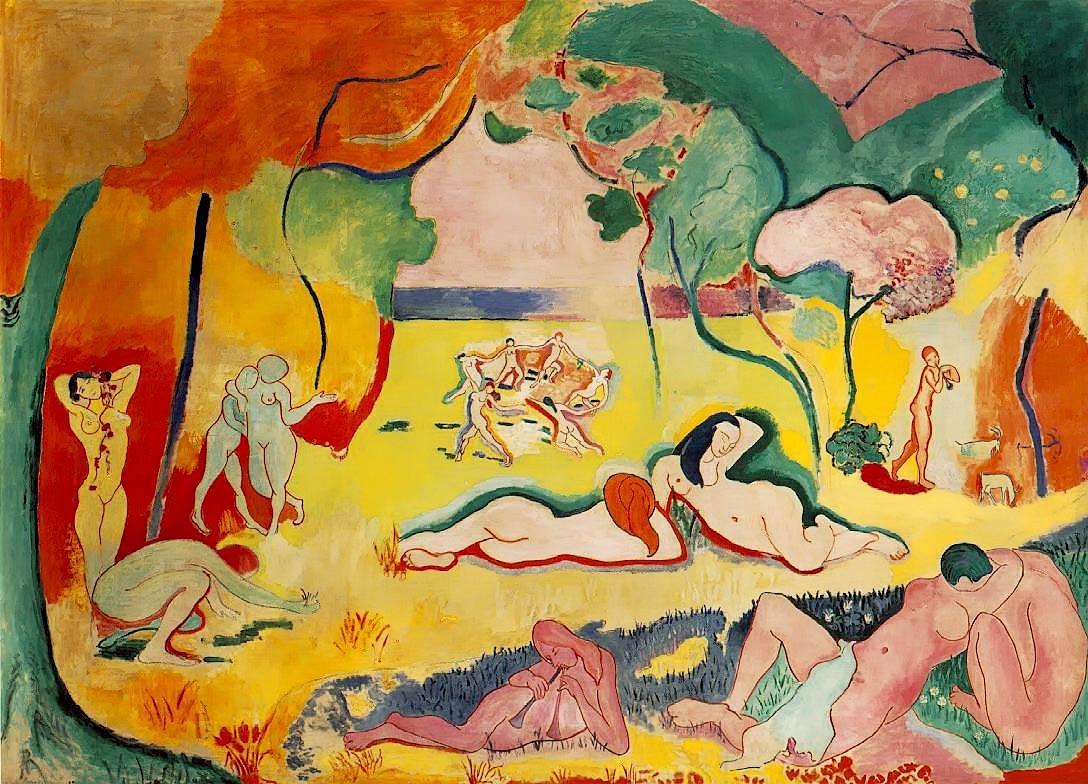
As we reflect on art in history, understand that paintings by artists like Vincent Van Gogh were not always accessible in their time. Matisse was unaware of Van Gogh's paintings until he was introduced to them by van Gogh's friend, and fellow painter, John Peter Russell. Seeing the color palette, joy, and energy expressed in Van Gogh's work inspired and encouraged Matisse to explore his own direction. This took courage from a man who was rejected and scorned for his lack of artistic abilities. Artists like Matisse were considered outsiders in the inner circles of the established art world by successful artists such as Bouguereau. For some modern painters we study today, creating successful visual art did not come easily. These artists struggled, yet persisted, in creating and advancing the techniques and approaches to visual art. How many influencial modern artists were rejected by the prestigious art schools and programs of their day? Matisse was one of those artists who was challenged by the rigors of academic art training, and considered the training too restrictive. He left the Académie Julian and was initially rejected by the the École des Beaux-Arts, but, by 1886, was elected as associate member of the Sociéte Nationale, enabling his paintings to be displayed at he salon.
Matisse discarded traditional ways of representing space and depth and experimented more with shapes and color interactions, simplification, and abstraction. In the painting Joy of Life, we see Matisse experience freedom in the placement of figures, include aspects of Art Nouveau's curvilinear forms, and distill painting down to the essence of the art elements of line, texture, color and shapes. The painting is flattened by the elimination of a recognizable light source and the use of the same color intensities of hue and value running from foreground to background. A more traditional approach to the subject is shown below demonstrating what the painting would look like with a light source (backlighting coming from the opening in the trees), the figures in a more natural size and scale, and shadows.
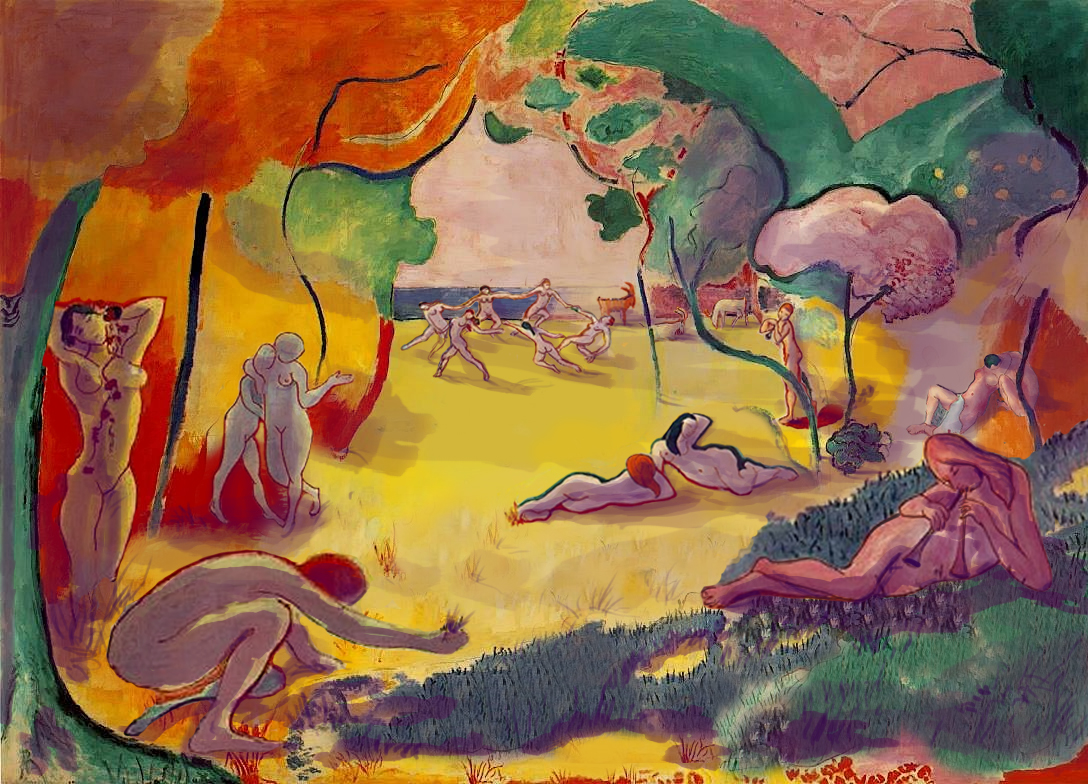

The Red Studio, 1911 Henri Matisse
https://www.youtube.com/watch?v=zDYlSLWAjQs
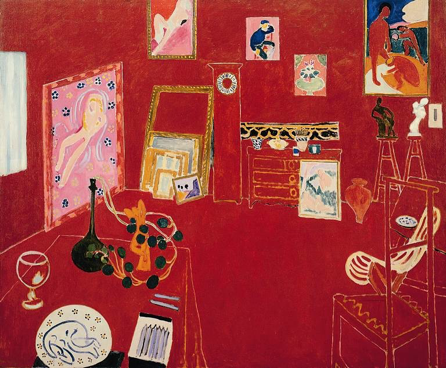

The influence on contemporary concept designers, animators, and artists can be seen in the opening credits for the animation Monsters, Inc. We see Matisse's Red Studio reflected in the animated door sequence. Paying homage to the artists who created paintings, sculpture, and architecture in earlier art periods is an important link to the past that artists often employ. Although often recognized by the discerning few, it helps to reinforce the Renaissance idea that art is meant for the educated. Of course, art can be appreciated by any viewer who takes the time to look and see the work.

Les Demoiselles d'Avignon, 1907 Pablo Picasso
https://www.youtube.com/watch?v=pngGDycLQuE
https://www.youtube.com/watch?v=XyLNPumMMTs
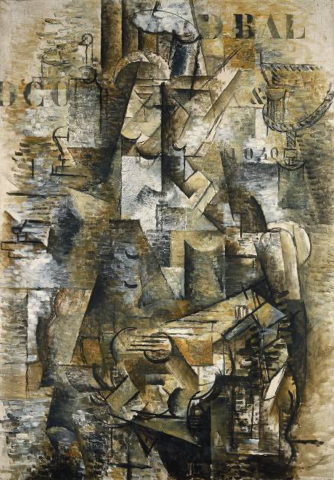
The Portuguese, 1911 Georges Braque
https://smarthistory.org/braque-the-portuguese/
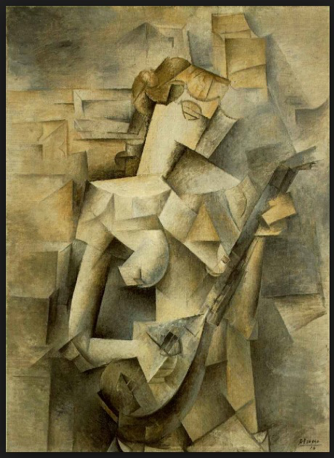
Girl with a Mandolin, 1910 Picasso
https://www.khanacademy.org/humanities/art-1010/cubism-early-abstraction/cubism/v/picasso-guitarist
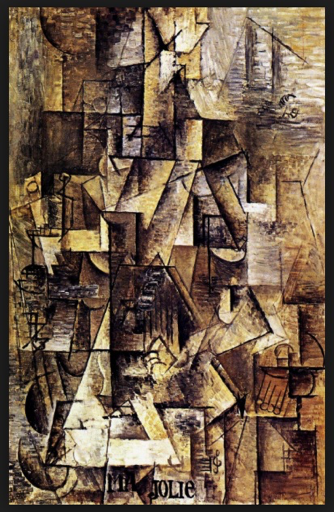
Ma Jolie, 1911-12 Picasso
https://www.youtube.com/watch?v=FskeS9S7X8A
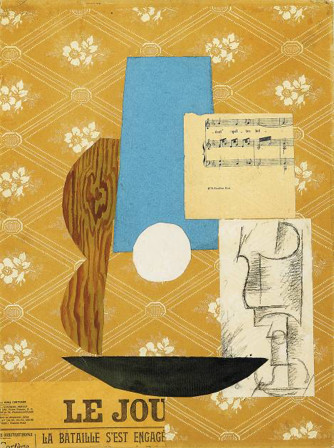
Guitar, Sheet Music, and Wine Glass, 1912 Pablo Picasso
https://www.metmuseum.org/art/collection/search/760178
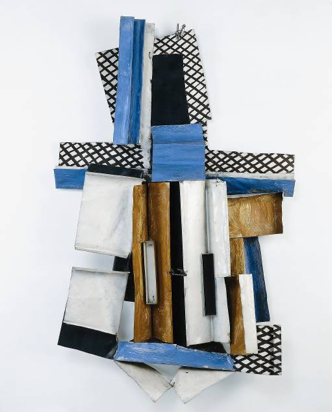
Violin, 1915 Pablo Picasso
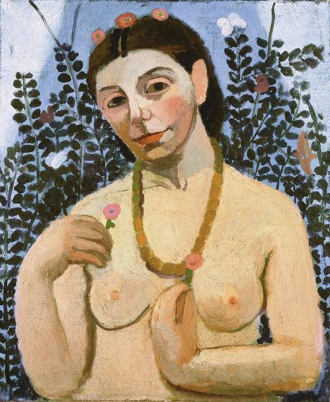
Self-Portrait with an Amber Necklace, 1913 Paula Modersohn-Becker
https://www.moma.org/artists/4037
Paula Modersohn-Becker presents a self-portrait where she takes possession of her own nude image in a bold painting. With a tilt of the head recalling both icon paintings, and Venus in Botticelli's Primavera, she paints her image in a natural, and unassuming space. The flowers repeat the shape of her nipples and are also featured in her hair. At a time when women were fighting for the right to vote and to work, she shows both strength and dignity in her painting.
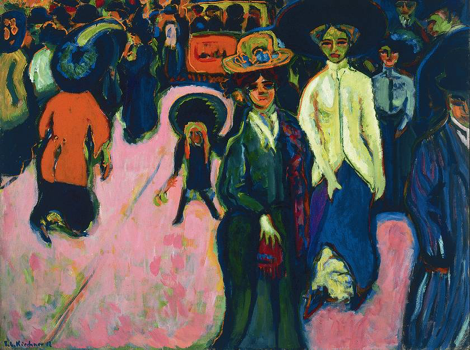
Street, Dresden, 1908 Ernst Ludwig Kirchner
https://smarthistory.org/kirchner-street-dresden/
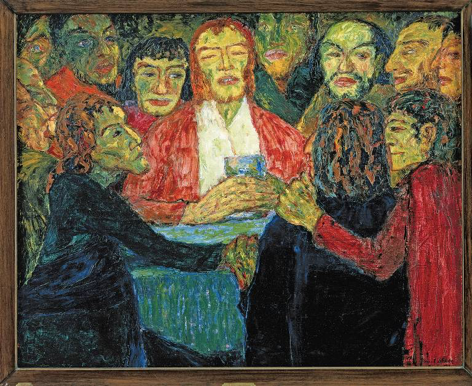
The Last Supper, 1909 Emil Nolde
https://app.smartify.org/en-GB/objects/emil-nolde-the-last-supper
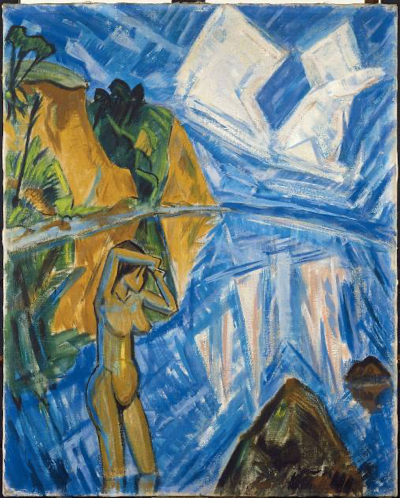
A Crystal Day, 1913 Erich Heckel
https://www.theartstory.org/artist/heckel-erich/


Peter Schlemihl: Tribulations of Love, 1915 Eranst Ludwig Kirchner
https://www.youtube.com/watch?v=PvB7Aq9X1Do
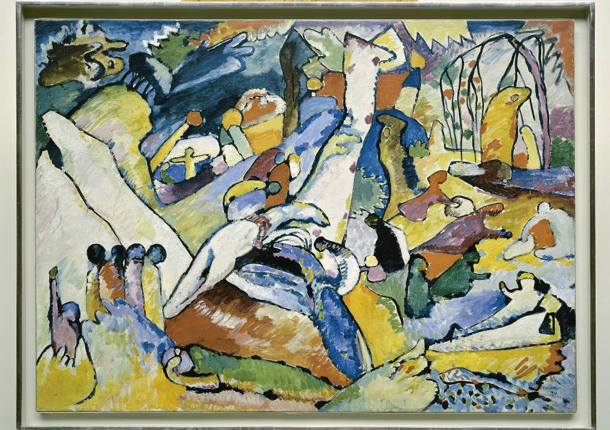
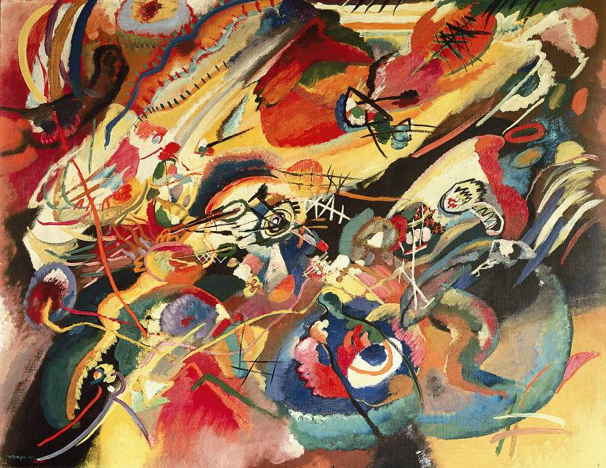
Sketch I for "Composition VII" 1913 Vasily Kandinsky
https://www.youtube.com/watch?v=0_YDrJoUe8s
https://www.youtube.com/watch?v=Sa3FyvaKYVw
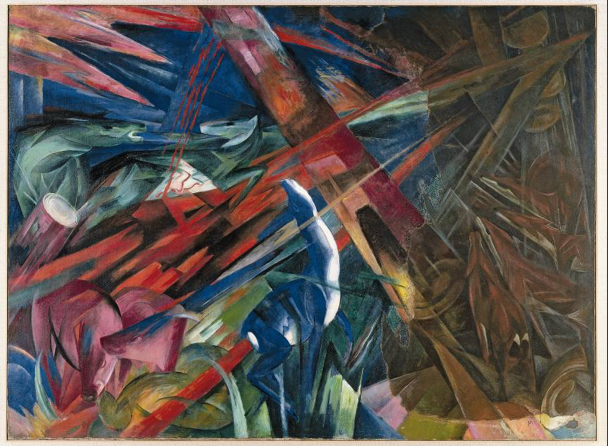
Animal Destinies, 1913 1913 Franz Marc
https://www.youtube.com/watch?v=1uvlxQfsBpQ
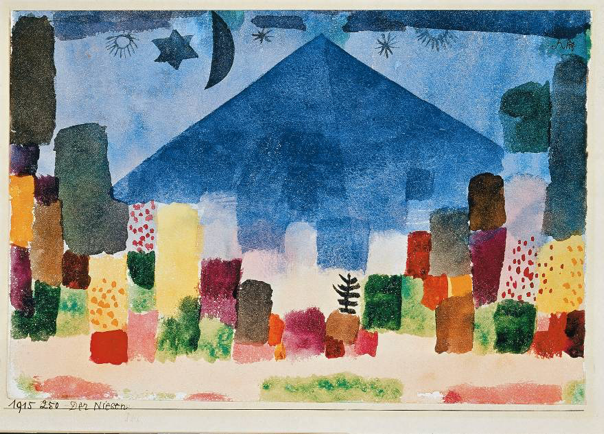
The Niesen, 1915 Paul Klee
https://www.metmuseum.org/perspectives/videos/2022/12/paul-klee
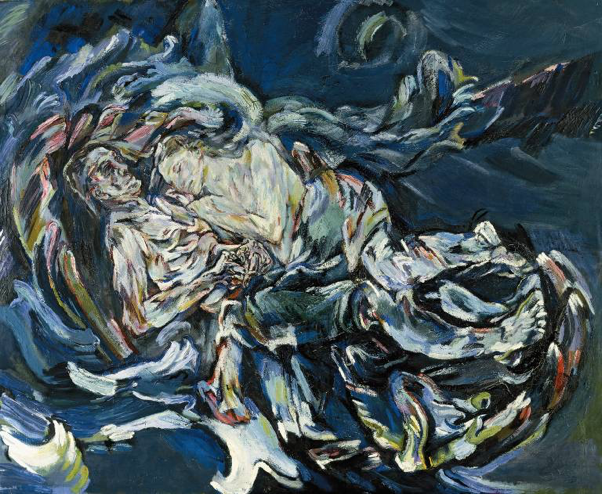
The Bride of the Wind, 1914 Oskar Kokoschka
https://www.youtube.com/watch?v=1xtcniYFAhw

Self-Portrait, 1910 Egon Schiele
https://www.youtube.com/watch?v=BN73JesYJhc
https://www.youtube.com/watch?v=t87YE71GPwM
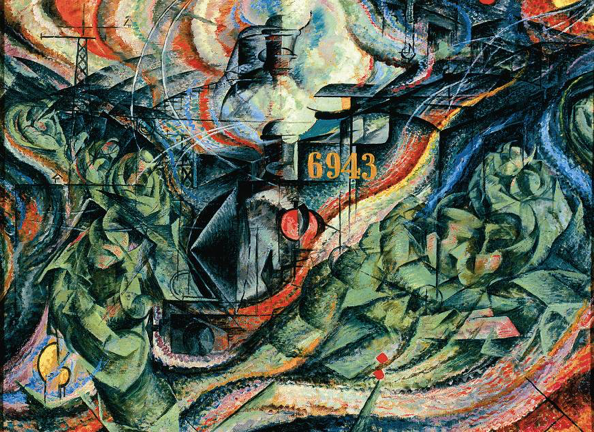
States of Mind I: Farewells, 1911 Umberto Boccioni
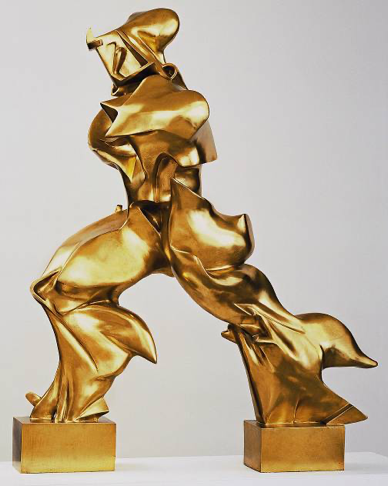
Unique Forms of Continuity in Space, 1913 Umberto Boccioni
https://www.youtube.com/watch?v=Wo8WN-iJ6RE
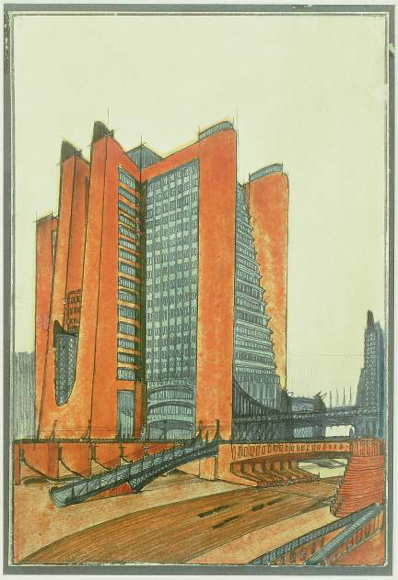
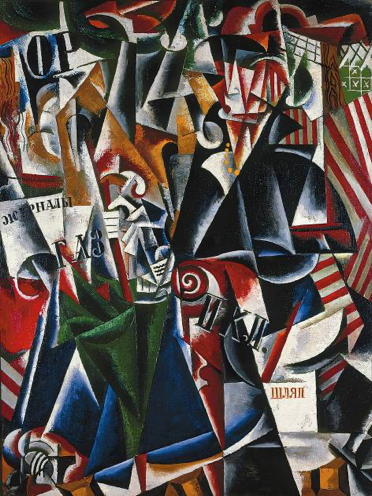
The Traveler, 1915 Lyubov Popova
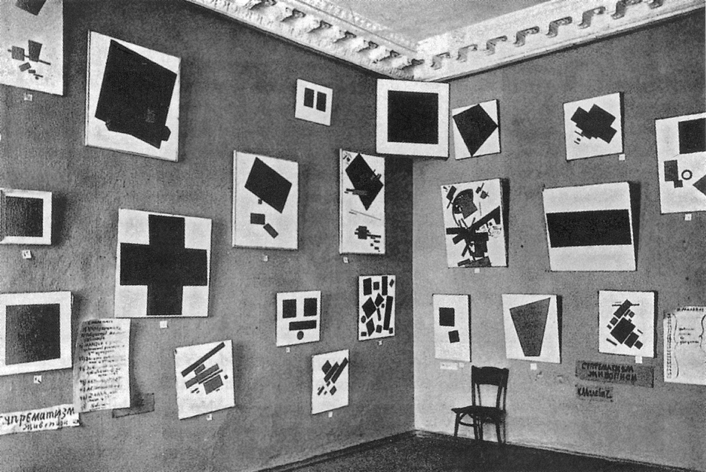
Kazimir Malevich, photo of his paintings, 1915
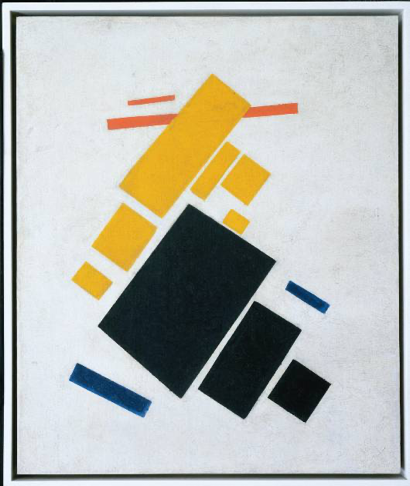
Suprematist Composition: Airplane Flying, 1915 Kazimir Malevich
https://www.youtube.com/watch?v=e3YS6uZ87Ec
https://www.youtube.com/watch?v=-TF_y0bJzIU
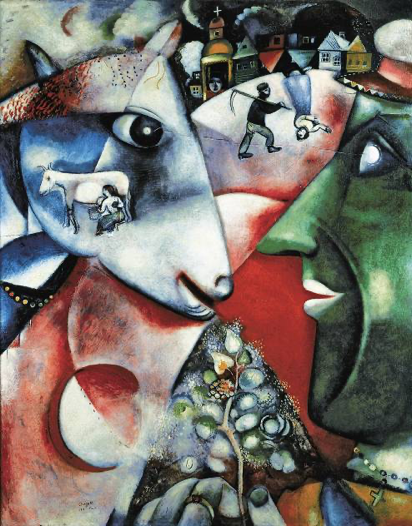
I and the Village, 1911 Marc Chagall
https://www.youtube.com/watch?v=VjgHErPUN1s
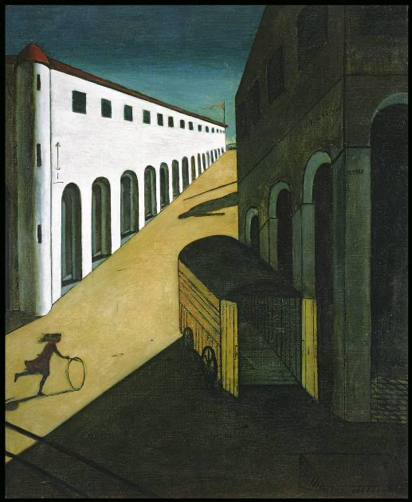
Mystery and Melancholy of a Street, 1914 Giorgio de Chirico
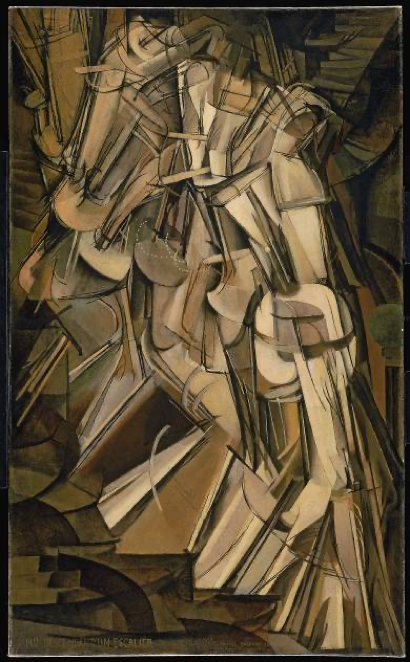
Nude Descending a Staircase, 1912 Marcel Duchamp
https://philamuseum.org/collection/object/51449
https://www.youtube.com/watch?v=uZnUTrfxbj0
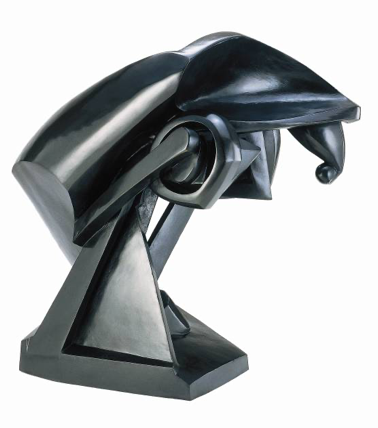

Horse, 1914 Raymond Duchamp-Villon Bicycle Wheel, 1913 Marcel Duchamp
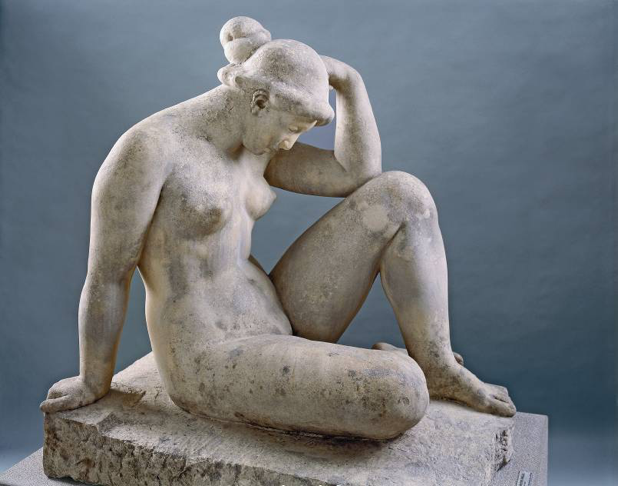
Aristide Maillol
https://www.youtube.com/watch?v=ChIDxCnGjHw
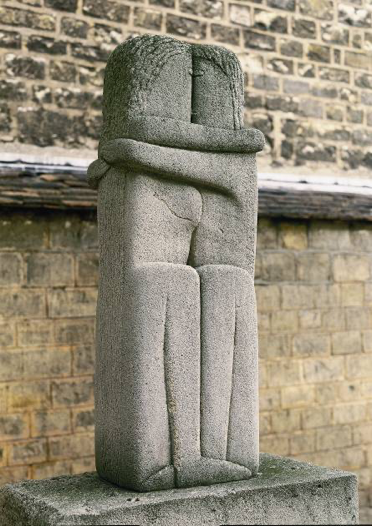

Brancusi (1909) Rodin (1889)
Rodin represents the physical passions of an embrace. The emotions and desires of both male and female are on display. The fact that they are nude adds to the universal message (clothing would place it both in time and place). Brancusi, on the other hand, gives us a “PG” version. It represents the idea of love through a kiss and embrace. This is further enhanced by one stone used to carve the two figures (monolithic mass). This is more abstract in concept and execution.
Both sculptures are art: same subjects, with very different meanings.

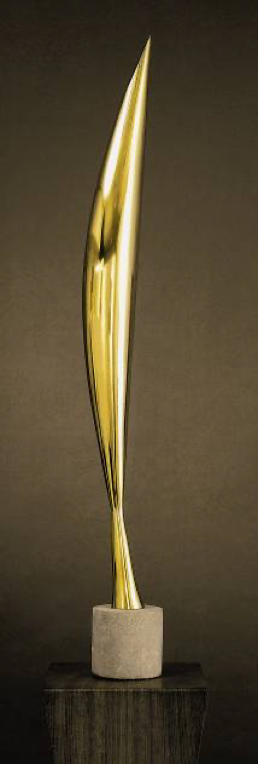
The Newborn, Constantin Brancusi 1915 Bird in Space, Constantin Brancusi 1928
https://www.youtube.com/watch?v=r3ttwvNvors


Fagus Factory, 1911 Walter Gropius and Adolf Meyer

